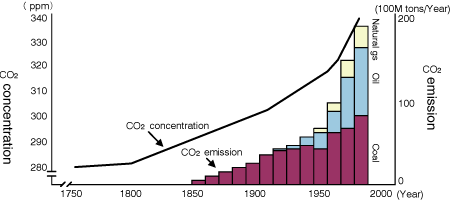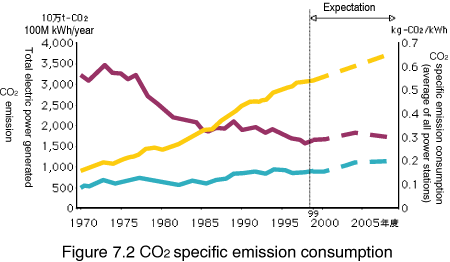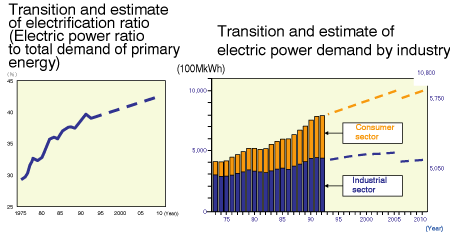<<The warming Globe>>
Of late, global warming is getting serious. The cause is increased
emission of greenhouse effect gas, such as carbon dioxide, etc.
due to increasing of consumption of coal and oil. The amount of
carbon dioxide in the air, compared with 200 years ago, has increased
by around 30% (See figure 6.1). Since the 19th century, human beings
got to consume a lot of coal and oil as industry developed. The
amount of carbon dioxide at the end of 20th would be nearly doubled
if we consume them by keeping the same activities. As a result,
the average temperature of the globe is expected to increase around
2。・higher than now.
With only 2。・increase, enormous influences would emerge.
Firstly, as global phenomena, a number of islands sinks in the
sea as sea level rises. Furthermore, warming temperature contributes
to abnormal climate affecting water circulation in everywhere in
the world. As a result, areas, where floods frequently occur, and
where droughts hit, would emerge.
In addition, other problems, such as increase of tropical infectious
diseases like malaria, and food problem due to decrease of agricultural
products and marine products, would bring up seriously situation
across the world even with a slight increase of temperature.
In the case of Japan, heat-island effect would be accelerated in
urban areas, sandy beach would decrease due to rise of sea level
resulting in enormous increase of dangerous areas that are easily
attacked by tidal wave and Tsunami.
Also, food problem would be our urgent concern as dependence on
food imports is high.

Figure 6.1 Change of carbon dioxide emission
from fossil fuel and carbon dioxide concentration in the air
In utilizing secondary energy, the most convenient and valuable
energy is electric energy (electric power).
Over the past 10 years, demand for electric power has greatly increased.
That is because the energy can be converted easily to mechanical
energy or thermal energy. It is efficiently utilized for many electrical
equipments and devices for which it cannot be easily replaced with
other energies.
However, those electrical equipments and devices are emitting carbon
dioxide, indirectly though. Electric energy itself is clean energy
but, we need to keep in mind that it emits carbon dioxide at the
same time as electric energy is generated.
CO2 specific emission consumption vs. total electric power at all
power stations.
(Amount of carbon dioxide developed by generating electric power
of 1kWh)

Figure 6.2 CO2 specific emission consumption
* Specific emission consumption is getting lower because of expansion
of nuclear power generation, efficiency improvement of thermal power
generation, and LNG thermal generation which gives less CO2 emission
among fossil fuel though electric power generation has increased.
Electricity we use is secondary energy, and it is produced by converting
various primary energy and reprocess it. Out of total demand for
primary energy like oil, coal, hydraulic power, liquid natural gas,
and nuclear power, ratio of energy which is converted to electric
power is called electrification ratio. Electrification ratio is
apt to increase year after year, and is expected to increase continuously.
As electric energy is able to change to light, power, heat source,
and electronics, it gives a lot of possibility to play an important
roll connected with with electronics to support IT society.

Figure 6.3 Transition and estimate of electrification ratio
and electric power demand
As seen in the figure above, power consumption is increasing from
year to year. In particular, demand for consumer sector including
household, building and commercial use is growing resulting in higher
ratio among total power demand. The reason why residential sector
is growing is that home appliances such as refrigerators, TVs, air
conditioners, washing machines, and electrified housing are spreading.
Also, micro computers have been built in electric home appliances
to always consume small power (standby power) to control additional
functions such as automatic operation,
remote control, and display of status of Stop/Operation.
Standby power may be small but, the influence to total consumption
across the country must be large as there are quite many appliances
that consumes power day and night.
As to business sector, a lot of power including standby power is
consumed by lightings and air conditioning at office buildings,
hotels, departments, and convenience
stores, or by OA equipments like PCs and faxes.
As discussed above, power demand is expected to be increasing year
to year, and still keep on. In order to control and reduce carbon
dioxide emission:
- "Electricity saving"
- "Energy saving"
- "New energy innovation"
are to be strong measures for us to suppress electricity consumption,
and we must tackle aggressively throughout the entire society.
<< Pushing ahead with "Electricity saving,"
"Energy saving." and "New energy innovation"
>>
In order to reduce electricity consumption, "Electricity
saving," "Energy saving," and "New energy innovation"
are to be tackled.
1) Electricity saving
"Electricity saving" is to eliminate energy itself that
is consumed in a wasted way. For example, frequently turning on
and off the lights, turning off the main switch of electric appliances
to eliminate standby power, higher setting temperature of refrigerators
and air conditioners, and so on. 70 to 80% of companies who are
tackling have introduced electricity saving of lights and air conditioners.
2) Energy Saving
"Energy saving" is to use energy with high efficiency
to reduce energy consumption, or loss. What we can do is to use
equipments with high efficiency, and home appliances are getting
to be energy saving type which achieve high efficiency. Of late,
in particular, power electronics technique has progressed to bring
high performance and energy saving. In home appliances and consumer
products, power electronics
technique has been implemented to inverters for lighting apparatuses,
air conditioning, and cooking equipments. For example, implementing
inverter circuit to lighting circuit of fluorescent bulb improves
luminance efficiency by 10% or more saving energy by approx. 20%
compared with traditional magnetic circuit voltage stabilizers.
3) New energy
New energy means newly developed energy to replace existing primary
energies such as oil, coal, natural gas, etc. Implementation of
new energy is greatly expected for its less limited resource and
low environmental burden due to less emission of CO2 among alternative
energy to oil.
Generally speaking, new energy is categorized into three types.
One is "Renewable energy" which is clean and has no limit
of resources such as solar energy and wind energy, Second is "Recycled
energy" which use waste and exhaust heat. Third is "New
form of utilization of traditional energy" which aims at higher
efficiency of traditional energy use and harmonization with environment.
Renewable energy:
Power generations by Solar power, Hydraulic power, Wind power, Solar
heat, Geothermal heat, etc.
Recycled energy:
Factory exhaust heat, Sewage heat, Utilization of wastes, Biomass,
etc.
New form of utilization of traditional energy:
Cogeneration, Fuel cells, etc. |

















